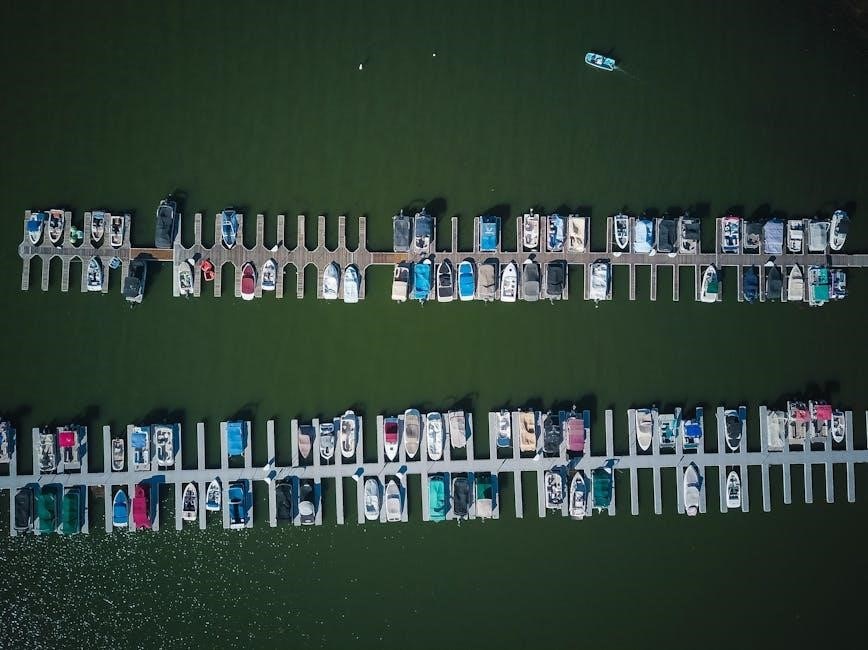
pontoon loading guides
Pontoon loading guides simplify the process of securing and transporting your boat, ensuring safety and efficiency with guide-ons and alignment systems designed for stress-free operations.
Why Pontoon Loading Guides Are Essential
Pontoon loading guides are crucial for ensuring safe and efficient boat transportation. They provide alignment and stability, preventing damage during loading and unloading. These systems act as visual aids and physical supports, reducing stress and the risk of accidents. Guides are especially beneficial for new boaters, as they simplify the process and ensure proper boat placement on the trailer. They also protect the boat from scratches and dings, making them a must-have for both experienced and novice boat owners.
Key Considerations for Safe and Efficient Loading
Proper weight distribution and balance are crucial for safe and efficient pontoon loading. Ensuring the boat is securely fastened to the trailer prevents shifting during transport. Guide-ons or guide rails assist in alignment, making the process smoother. Regular inspection of both trailer and boat is essential to identify and address any wear or damage. Adapting loading techniques to different water and weather conditions enhances stability and safety. Always follow manufacturer guidelines for loading capacities and use additional tie-downs for safety.
Pre-Loading Preparation
Before loading, inspect the trailer and boat for damage, ensuring proper function of brakes and lights. Secure loose items on the boat and prepare tie-down straps for safe transport.
Understanding Weight Distribution and Capacity
Proper weight distribution is crucial for safe and efficient loading. Ensure the pontoon boat’s weight is evenly spread across the trailer’s axle, avoiding overload on one side. Check the trailer’s Gross Vehicle Weight Rating (GVWR) and the boat’s maximum capacity to prevent exceeding limits. Exceeding these can lead to instability during transport and potential legal issues. Always calculate the combined weight of the boat, motor, and gear to stay within safe parameters for smooth operations and compliance with regulations.
Securing the Pontoon Boat for Transport
Securing your pontoon boat for transport is vital for safety and stability on the road. Use high-quality tie-down straps to fasten the boat to the trailer, ensuring even tension across the hull. Install guide-ons or roller systems to center the boat and prevent shifting. Tighten all connections firmly and double-check for looseness before towing. Additionally, consider using ratchet straps for extra security and foam padding to protect the pontoons from abrasion during transit.

The Loading Process
The loading process involves aligning the pontoon boat with the trailer, centering it, and securing it using guide-ons and straps for stability and safety during transport.
Step-by-Step Guide to Loading Your Pontoon Boat
Start by aligning the boat with the trailer, using guide-ons for precision. Center the pontoon on the trailer, ensuring even weight distribution. Secure the boat with straps, tightening gradually to avoid shifting. Check alignment and stability before towing. For added visibility, consider white PVC extensions on guide-ons, especially in windy conditions. Ensure the trailer’s bunks are properly positioned to support the boat’s hull. Finally, double-check all fasteners and lights for a safe transport experience.
Using Trailer Guides for Alignment and Stability
Trailer guides, such as guide-ons or alignment poles, are essential for precise loading and unloading. They provide visual cues to help center the pontoon boat on the trailer, ensuring proper alignment and balance. Made from durable materials like galvanized steel, these guides enhance stability and reduce the risk of damage. Installation is straightforward, often using U-bolts for secure mounting; Adjustable features allow customization to fit various boat sizes, while visibility enhancements like white PVC extensions improve ease of use in challenging conditions.

Safety Tips and Best Practices
Always maintain stability by centering the boat on the trailer. Secure loose items to prevent shifting during transport. Use visual guides for alignment and stress-free loading.
Ensuring Stability During Loading and Unloading
To maintain stability, ensure the pontoon boat is evenly distributed on the trailer. Use guide-ons or rollers to align the boat properly. Lower the boat slowly into the water, keeping it centered to avoid tilting. On land, secure the boat tightly to the trailer frame with straps or chains. Always check the trailer’s leveling and ensure the boat floats freely during unloading. Slow, deliberate movements and proper alignment are key to preventing accidents and ensuring a smooth process.
Common Mistakes to Avoid
One of the most common mistakes is improper alignment during loading, which can cause the boat to tilt or scrape. Overloading the trailer beyond its capacity is another error, risking structural damage. Neglecting to secure the boat properly with straps or chains can lead to shifting during transport. Additionally, moving too quickly during loading or unloading can destabilize the boat. Always ensure the trailer is level and the boat is centered to avoid these issues and ensure a safe, smooth process.
Maintenance and Inspection
Regular trailer and boat inspections ensure safety and longevity. Check for wear on straps, bunks, and guides. Maintain service logs for tracking maintenance and repairs.
Checking the Trailer and Boat Before Loading

Before loading, inspect the trailer’s frame, axles, and tires for wear or damage. Ensure the boat’s hull is free of damage and all systems, including electrical and plumbing, are functioning properly. Check the bunk carpet for tears and the guide-ons for alignment. Verify that all straps and chains are secure and in good condition. Review the service log to ensure routine maintenance is up to date, and address any issues before proceeding with loading.
Post-Loading Inspection Routine
After loading, perform a thorough inspection to ensure everything is secure. Check that the boat is properly aligned on the trailer and tied down with straps and chains. Verify that all lights and brakes are functioning correctly. Inspect the trailer’s tires, ensuring they are inflated to the recommended pressure. Double-check the guide-ons for proper alignment and stability. Make sure all loose items are secured to prevent movement during transport. Finally, review the entire setup to ensure compliance with safety standards and legal requirements before heading out on the road.
Legal and Regulatory Compliance
Ensure compliance with local and state regulations by securing proper permits and following safety standards. Consult Transport Canada or NSW Boating Handbook for detailed requirements.
Understanding Local and State Regulations
Adhering to local and state regulations is crucial for legal and safe pontoon boat transportation. Research permits, weight limits, and environmental rules. In locations like NSW, consult the Boating Handbook or Transport Canada guidelines for detailed requirements. Ensure your trailer and boat comply with inspections and permits. Familiarize yourself with specific waterway restrictions and safety standards to avoid penalties. Always verify updated regulations before transporting your pontoon boat to ensure compliance and avoid legal issues.
Documentation and Permits Required
Proper documentation and permits are essential for legal pontoon boat transport. Ensure your boat is registered and insured, with up-to-date paperwork. Obtain any necessary permits for oversized loads or environmental zones. Refer to resources like the NSW Boating Handbook or Transport Canada guidelines for specific requirements. Maintain a Service/Maintenance Log for record-keeping. Always carry proof of ownership and insurance during transport. Verify local regulations to ensure compliance and avoid legal complications during transit.

Advanced Loading Techniques
Advanced techniques involve using guide-ons and alignment systems for precise docking. These tools enhance efficiency and stability, ensuring smooth loading even in challenging weather conditions.
Using Technology for Smoother Operations
Advanced loading systems now incorporate technology like GPS-guided alignment and sensor-activated feedback to streamline the process. These tools provide real-time data, ensuring precise positioning and reducing the risk of errors. Digital guides and apps offer step-by-step instructions, while automated systems adjust for water levels and weight distribution. This integration of technology enhances safety, efficiency, and ease of operation, making even complex loading scenarios manageable for experienced and novice users alike.
Adapting to Different Water and Weather Conditions
When loading or unloading your pontoon boat, it’s crucial to adapt to varying water and weather conditions. Calm waters allow for straightforward alignment, while choppy or windy conditions may require slower, more precise movements. Use guide-ons or additional support structures to maintain stability in rough water. Always monitor weather forecasts to avoid loading during storms, as strong winds or waves can destabilize the boat and trailer, increasing the risk of accidents or damage.
Troubleshooting Common Issues
Troubleshooting common loading issues ensures smooth operations. Address misalignment, instability, or equipment malfunctions promptly. Adjust trailer angles, check guide-ons, and secure the boat properly to resolve problems quickly.
Solving Problems During Loading and Unloading
Addressing issues during loading and unloading is crucial for a smooth experience. Common problems include misalignment, instability, or equipment malfunctions; To resolve these, ensure proper trailer alignment, use guide-ons for stability, and check for adequate flotation. Secure the boat firmly with straps and winches, and adjust the trailer angle if necessary. Regularly inspect hardware for damage or wear. Quick problem-solving prevents delays and ensures safe, efficient loading and unloading processes.
- Adjust trailer angles for proper alignment.
- Use guide-ons to stabilize the boat during loading.
- Ensure the boat is securely fastened with straps and winches.
- Inspect hardware for damage or wear before each use.
By addressing these issues promptly, you can minimize challenges and ensure a hassle-free experience.
Emergency Procedures
In case of an emergency during loading or unloading, remain calm and act quickly. If the boat shifts or becomes unstable, stop immediately and reassess the situation. Ensure all passengers are safe and clear of the area. If water enters the boat, secure it to prevent sinking. Communicate with nearby assistance if needed. Keep emergency contact numbers handy and follow local safety protocols. Regular practice of these procedures ensures readiness and minimizes risks during critical moments.
- Stop operations if instability occurs.
- Secure the boat and ensure passenger safety.
- Contact emergency services if necessary.
Preparedness is key to handling emergencies effectively and safely.
Pontoon loading guides provide essential tools for safe, efficient, and stress-free boat handling, ensuring a successful experience for both novice and experienced boat owners alike.
Final Thoughts on Mastering Pontoon Loading
Mastery of pontoon loading requires careful preparation, attention to detail, and practice. By using guide-ons, ensuring proper alignment, and maintaining equipment, you can achieve a stress-free experience. Regular maintenance and understanding local regulations further enhance safety and efficiency. With patience and adherence to best practices, loading your pontoon becomes a seamless process, allowing you to enjoy secure and enjoyable time on the water.